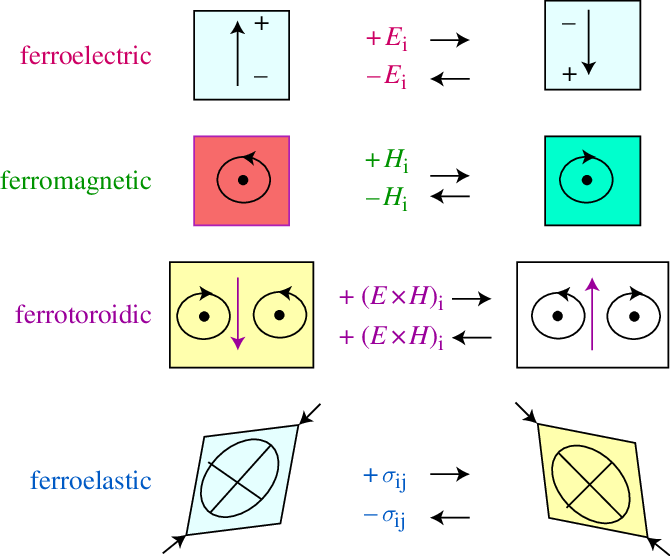Multiferroics: The Intersection of Multiple Ferroic Orders
What are Multiferroics?
Multiferroics are a class of materials that exhibit more than one type of ferroic order simultaneously in a single phase. Ferroic orders include ferromagnetism (spontaneous magnetic ordering), ferroelectricity (spontaneous electric polarization), ferroelasticity (spontaneous strain), and ferrotoroidicity (spontaneous toroidal moment). In multiferroics, these different ferroic orders coexist and often interact with each other, giving rise to unique and coupled properties.

Types of Multiferroics
Multiferroics can be broadly classified into two types based on the origin and strength of the coupling between the ferroic orders:
Type-I Multiferroics
In Type-I multiferroics, the different ferroic orders originate from distinct sublattices or structural units in the material. The coupling between the orders is usually weak, and the ferroic transition temperatures are often well separated. Examples of Type-I multiferroics include BiFeO3, YMnO3, and BaMnO3.
Type-II Multiferroics
Type-II multiferroics exhibit strong coupling between the ferroic orders, which often share a common origin. In these materials, one ferroic order (usually ferroelectricity) is induced by another order (usually magnetism) through a specific mechanism. The induced ferroelectricity is typically weaker compared to Type-I multiferroics. Examples of Type-II multiferroics include TbMnO3, MnWO4, and CoCr2O4.
Ferrotoroidic Order
Ferrotoroidicity is a less common but important ferroic order in multiferroics. It refers to the spontaneous alignment of magnetic vortices or toroidal moments in a material. A toroidal moment arises from a circular arrangement of magnetic moments or electric dipoles, forming a vortex-like structure. Ferrotoroidic materials exhibit a uniform alignment of these toroidal moments, leading to a macroscopic toroidal state.
The ferrotoroidic order is closely related to the magnetoelectric effect, as it can induce a magnetoelectric response in the material. The coupling between the ferrotoroidic order and other ferroic orders, such as ferromagnetism and ferroelectricity, can give rise to novel phenomena and enhanced multiferroic properties.
Examples of multiferroic materials exhibiting ferrotoroidic order include LiCoPO4, Co3O4, and MnTiO3.
Magnetoelectric Coupling in Multiferroics
One of the most interesting aspects of multiferroics is the magnetoelectric coupling, which refers to the interaction between the magnetic and electric orders in the material. This coupling allows for the control of the magnetic properties by an electric field and vice versa. The magnetoelectric effect can be linear or higher-order, depending on the symmetry and the strength of the coupling.
The magnetoelectric coupling in multiferroics can arise from various mechanisms, such as:
- Exchange Striction: In this mechanism, the ferroelectric polarization is induced by the symmetric exchange interaction between the magnetic ions. The displacement of the ions due to the magnetic ordering leads to a polar distortion and electric polarization.
- Spin-Current Model: This mechanism explains the ferroelectricity induced by non-collinear magnetic structures, such as spiral or cycloidal spin orders. The spin current generated by the non-collinear magnetism couples to the lattice and induces electric polarization.
- Inverse Dzyaloshinskii-Moriya Interaction: In this mechanism, the ferroelectric polarization is induced by the antisymmetric exchange interaction between the magnetic ions, known as the Dzyaloshinskii-Moriya interaction. The strength and direction of the induced polarization depend on the spin configuration and the symmetry of the crystal.
Applications of Multiferroics
Multiferroics offer exciting possibilities for various applications due to their unique coupled properties. Some of the potential applications include:
Data Storage
Multiferroics can be used for the development of novel data storage devices, such as multistate memory elements and electric-field controlled magnetic memory. The ability to control the magnetic state by an electric field can lead to low-power, high-density, and non-volatile memory devices.
Sensors and Actuators
The magnetoelectric coupling in multiferroics can be exploited for the design of sensitive magnetic field sensors and magnetoelectric actuators. These devices can convert magnetic signals into electrical signals and vice versa, enabling novel sensing and actuation capabilities.
Spintronics
Multiferroics are promising materials for spintronic applications, where the spin degree of freedom of electrons is utilized for information processing. The ability to control the spin state by an electric field in multiferroics can lead to low-power and efficient spintronic devices, such as spin valves and spin-transfer torque devices.
Challenges and Future Perspectives
Despite the immense potential of multiferroics, there are several challenges that need to be addressed for their widespread application. One of the main challenges is the scarcity of room-temperature multiferroics with strong magnetoelectric coupling. Many multiferroics exhibit their unique properties only at low temperatures, limiting their practical use.
Future research in multiferroics will focus on the discovery and design of new materials with robust room-temperature multiferroic properties. The use of advanced characterization techniques, such as neutron scattering, x-ray absorption spectroscopy, and high-resolution electron microscopy, will provide deeper insights into the underlying mechanisms and structure-property relationships in multiferroics.
The integration of multiferroics with other functional materials, such as semiconductors and 2D materials, will also open up new avenues for the development of multifunctional devices. The exploration of multiferroic heterostructures and interfaces can lead to the emergence of novel coupled phenomena and enhanced magnetoelectric effects.
Further Reading
Nature Reviews Materials, The evolution of multiferroics
National Science Review, Multiferroics: a beautiful but challenging multi-polar world
National Science Review, Single-phase multiferroics: new materials, phenomena, and physics
